Physical Address
304 North Cardinal St.
Dorchester Center, MA 02124
Physical Address
304 North Cardinal St.
Dorchester Center, MA 02124
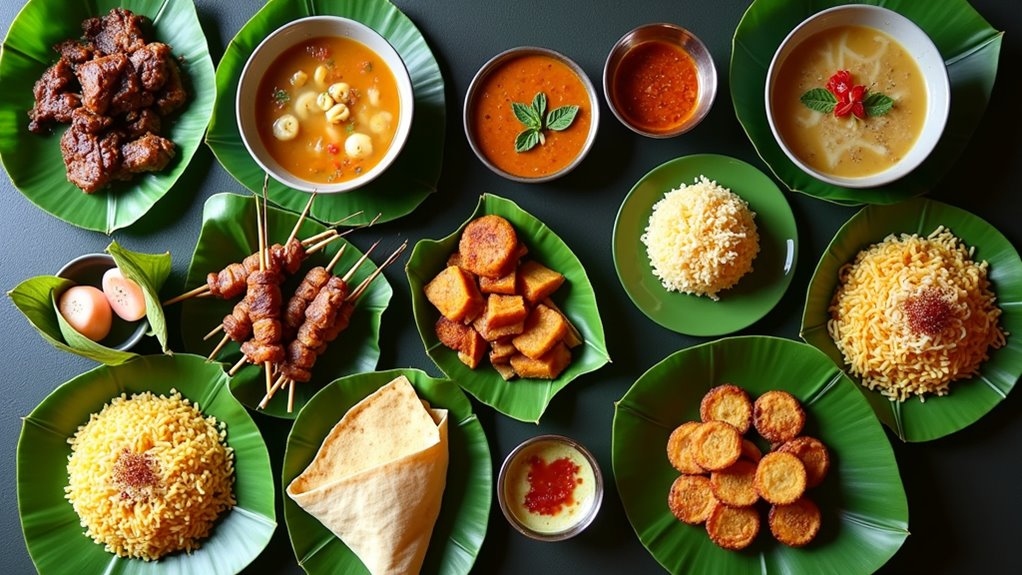
Wondering which Malaysian dishes capture the essence of its multicultural culinary landscape? These 9 treasures will transform your food journey.
Malaysian cuisine blends Malay, Chinese, and Indian influences into a vibrant food culture. You’ll want to try nasi lemak (coconut rice with sambal), spicy laksa soup, flaky roti canai, grilled satay with peanut sauce, char kway teow noodles, stuffed murtabak pancakes, and slow-cooked rendang. Don’t miss cooling cendol dessert and exploring bustling hawker centers for authentic street food. These nine dishes offer just a taste of Malaysia’s abundant culinary heritage.
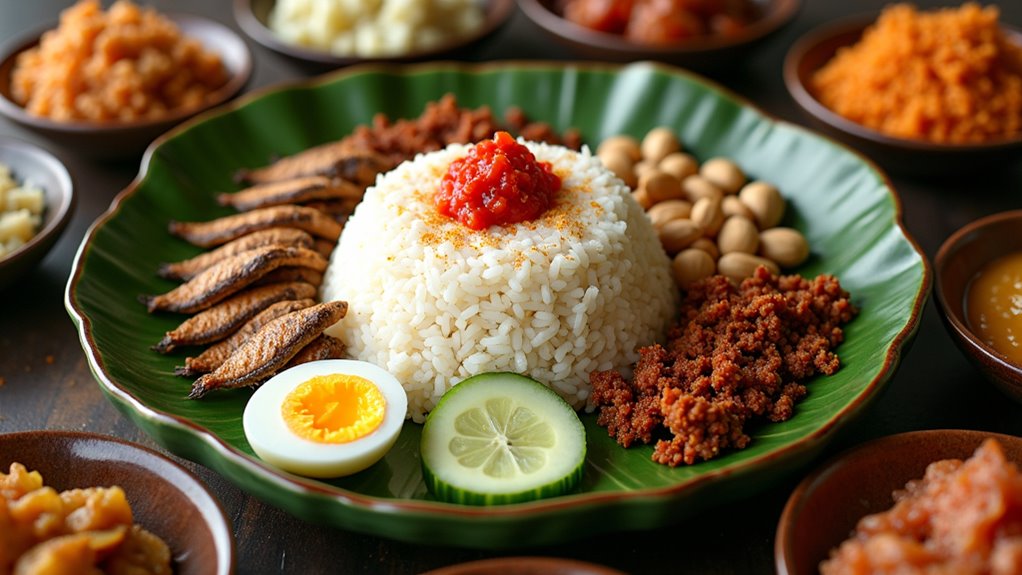
What makes a dish truly emblematic of a nation’s culinary identity? Nasi lemak answers this question through its perfect balance of flavors and textures that have captivated Malaysia since the 19th century.
This “fatty rice” features coconut milk-steamed rice with pandan leaves, served with sambal chili paste, fried anchovies, roasted peanuts, cucumber slices, and egg. Much like Korean food culture emphasizes balance through complementary flavors and textures, nasi lemak achieves harmony through its combination of spicy, sweet, savory, and crunchy elements. You’ll find it traditionally wrapped in banana leaves, enhancing its aromatic profile.
Originally a farmer’s energy meal, nasi lemak has evolved to include various proteins like ayam goreng (fried chicken), beef rendang, or sambal cuttlefish. Regional variations across Malaysia showcase unique local ingredients, such as the yellow rice version found in Alor Setar in northern Kedah.
Whether you enjoy it as a breakfast staple from hawker stalls or try upscale versions with premium ingredients, this dish’s cultural significance earned it a Google Doodle tribute in 2019.
How could any exploration of Malaysian cuisine be complete without celebrating the vibrant, aromatic laksa that enthralls foodies worldwide? This spicy noodle soup represents Malaysia’s cultural diversity, with its Peranakan roots blending Chinese and Southeast Asian culinary traditions.
You’ll find regional variations like Penang Laksa and Laksa Johor, each showcasing distinct flavor profiles. The dish typically combines homemade spice paste with coconut milk, lemongrass, galangal, and chili peppers, creating a perfect balance of spicy, sour, and savory notes. Making authentic laksa requires carefully sautéing the laksa paste in oil to release its complex flavors before adding the broth ingredients.
Whether you’re sampling it from street vendors or upscale restaurants, laksa offers a complete meal with your choice of noodles, proteins like chicken or shrimp, and fresh herbs. It’s a testament to Malaysia’s opulent culinary heritage and diverse cultural influences. When enjoying laksa in Singapore, you can dine with peace of mind as it’s far safer than encountering the dangerous animals that inhabit other parts of the region.
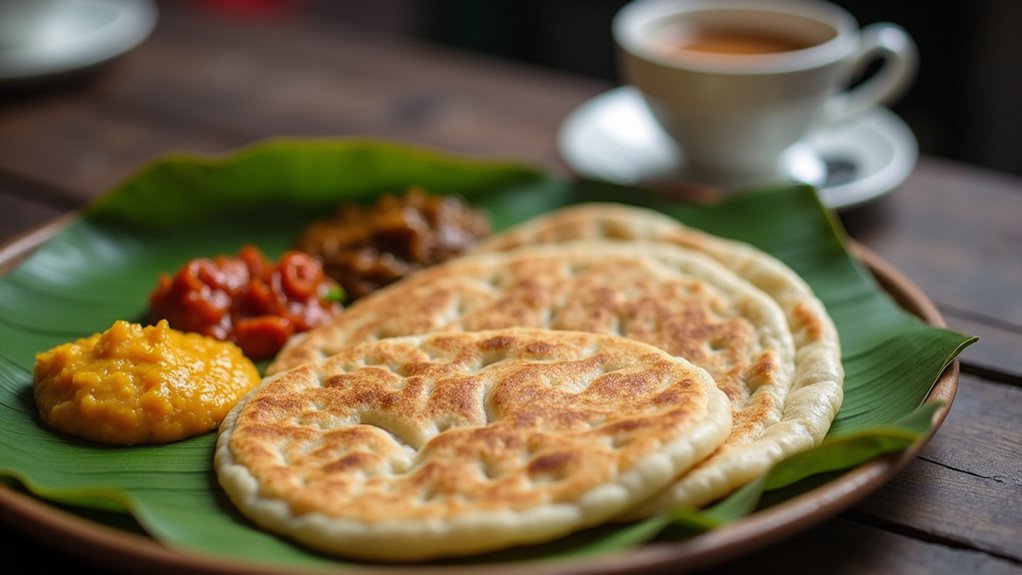
Waking up in Malaysia often leads to one of the country’s most beloved culinary treasures: Roti Canai. This Indian-influenced flatbread has become a breakfast staple across the nation, particularly in bustling Mamak restaurants where locals gather to start their day. Its widespread popularity resembles how instant uttapam provides a colorful, nutritious breakfast option in Indian cuisine.
Roti Canai beckons hungry Malaysians each morning, drawing them to lively Mamak stalls for that perfect crispy-soft sensation.
You’ll find this versatile dish served throughout the day, but nothing beats enjoying it fresh off the griddle for breakfast. When traveling in China, be aware that table manners differ significantly from Malaysia, so observing local customs enhances your dining experience.
Among Malaysia’s most iconic culinary treasures, satay emerges as a dish that captures the essence of the country’s diverse food culture. These skewered morsels of chicken, beef, or pork are marinated in a fragrant blend of lemongrass, turmeric, garlic, and other spices before being grilled over charcoal for that distinctive smoky flavor.
You’ll find satay at vibrant night markets and street food stalls across Malaysia. The dish exemplifies the rich flavors that make Malaysian cuisine so renowned throughout Southeast Asia. It’s traditionally served with a sumptuous peanut sauce made from coconut milk, tamarind, and chilies, alongside cucumber slices, onions, and ketupat rice cakes.
The preparation is relatively quick—just 2-3 minutes per side on the grill. Malaysian satay is widely considered to have the best recipe globally, setting it apart from other Southeast Asian versions. This beloved street food reflects Malaysia’s cross-cultural heritage and remains a staple at social gatherings throughout the country.
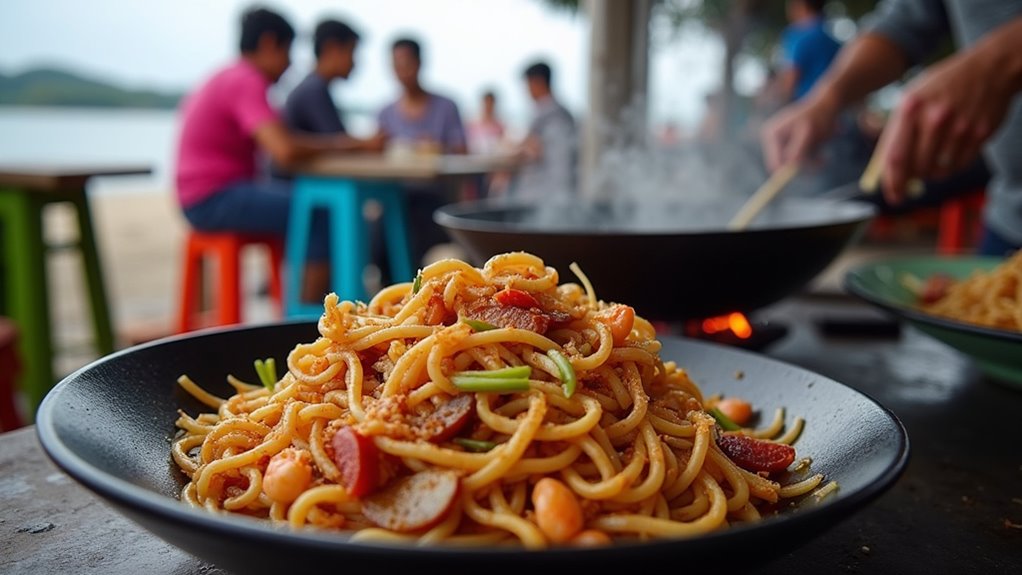
Char Kway Teow stands as Penang’s most celebrated noodle dish, enthralling foodies with its smoky aroma and complex flavors. This iconic street food combines flat rice noodles with a medley of fresh ingredients, all wok-fried at high heat to achieve the coveted “wok hei” – that distinctive charred essence that defines authentic Malaysian cooking. True enthusiasts insist on using dark soy sauce mixed with regular soy sauce and oyster sauce for the dish’s characteristic rich color and depth of flavor. Just as Vietnamese locals say cảm ơn bạn to express gratitude after a delicious meal, Malaysians often nod appreciatively when served an authentic plate of Char Kway Teow.
Murtabak, a beloved Malaysian stuffed pancake with Middle Eastern roots, represents a perfect union of culinary traditions across continents. Its name evolved from Arabic “mutabbaq” (folded) after Tamil Muslim traders introduced it to Malaysia.
You’ll find this iconic dish at 24/7 Mamak stalls, where skilled vendors stretch elastic wheat dough paper-thin before filling it with spiced minced meat, onions, and eggs. The multiple layers created through expert folding techniques provide textural complexity that distinguishes quality murtabak from simpler flatbreads. The pancake is then griddle-fried with ghee until crispy.
Each region offers unique variations – try Kelantan’s spicy mutton version or explore modern interpretations with cheese or black pepper squid. For travelers seeking budget-friendly options, murtabak offers a satisfying meal that won’t break the bank while exploring Malaysia. During Ramadan, murtabak becomes especially popular for iftar meals.
The humble murtabak transforms across Malaysia’s diverse landscape, from fiery Kelantanese renditions to contemporary fusion creations that captivate hungry Ramadan crowds.
Enjoy yours with traditional accompaniments like pickled onions, curry gravy, or cool cucumber raita for the authentic experience.
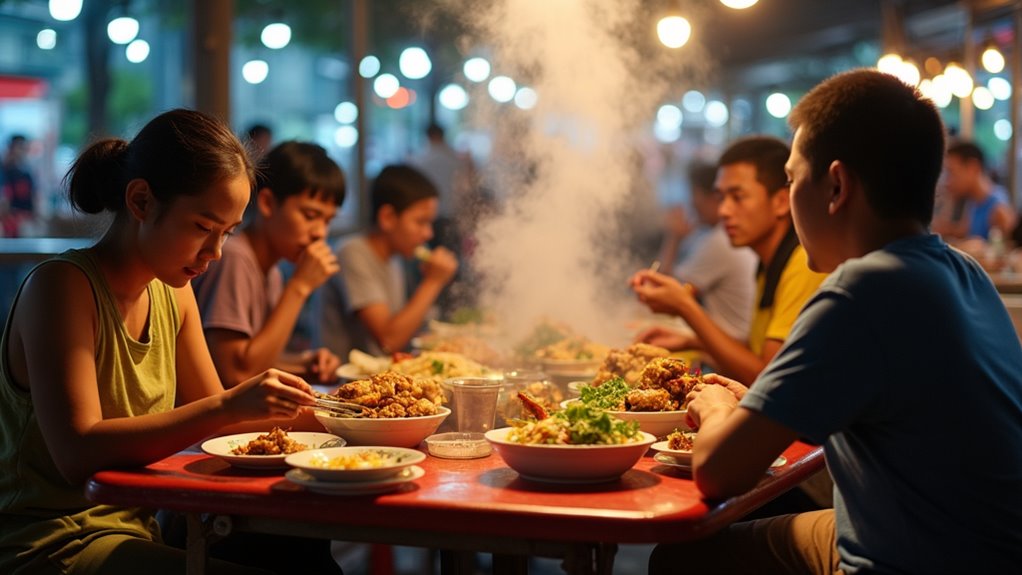
At the heart of Malaysia’s vibrant culinary scene, you’ll find bustling hawker centers where mouthwatering aromas and sizzling woks create an unforgettable street food paradise. These open-air complexes house thousands of vendors crafting affordable delicacies that preserve Malaysia’s diverse culinary heritage. The country has seen consistent growth in the number of street stalls and kiosks from 2016 to 2022, with further expansion projected through 2026. Malaysian street food reflects the rich flavors found throughout Asia, with particularly strong Chinese influences evident in many popular dishes.
Most meals cost under RM10, making hawker centers both culturally significant and economically accessible for everyone from locals to curious travelers.
When Malaysia’s tropical heat becomes overwhelming, locals and visitors alike turn to cendol, the nation’s beloved icy dessert that perfectly balances sweetness, creaminess, and refreshment. This iconic treat features distinctive green rice flour jellies layered with luscious palm sugar syrup (gula melaka), creamy coconut milk, and crushed ice.
The magic lies in its contrasting elements—chewy pandan-flavored jellies against smooth coconut milk, all sweetened by caramel-like palm sugar. You’ll find cendol at nearly every hawker center, particularly renowned in Penang. Some vendors add red azuki or mung beans for extra texture. The versatility of cendol allows for various additional toppings that enhance both flavor and textural experience.
While indulgent in calories, this centuries-old dessert offers a true taste of Malaysian culture, remaining largely unchanged despite its growing international recognition.
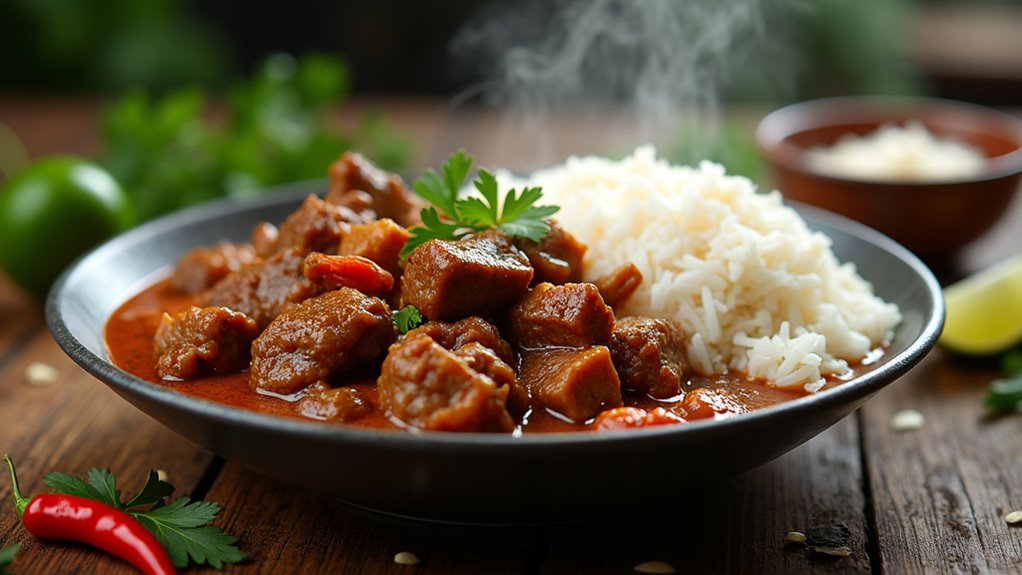
Among Malaysia’s most celebrated dishes, rendang stands as a culinary masterpiece that exemplifies the art of slow cooking and complex flavor development. Originally from Minangkabau, Indonesia, this iconic dish has become firmly embedded in Malaysian cuisine, often appearing at special occasions and family gatherings. The dish is believed to have reached Malaysia through Minangkabau settlers who came from Sumatra during the era of the Melaka Sultanate. While tourist favorites like rendang offer exceptional value, many travelers find that local food prices in Southeast Asia are surprisingly affordable compared to Western countries.
You’ll find rendang characterized by:
The dish varies slightly across regions, but each version offers that unmistakable rendang experience combining savory, sweet, and spicy notes.
Malaysian cuisine’s vibrant tapestry reflects the nation’s cultural mosaic. You’ll find yourself transported by the aromatic symphony of Nasi Lemak, mesmerized by Laksa’s fiery dance, and comforted by Rendang’s opulent embrace. From hawker centers to family tables, these nine dishes are your gateway to understanding Malaysia’s heart. Don’t just visit Malaysia—taste it, savor it, and let its flavors tell you stories that words simply cannot capture.